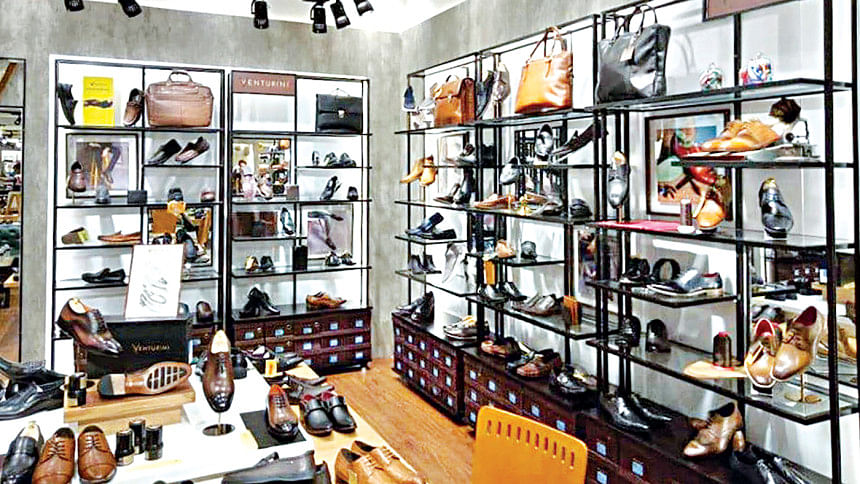Cheap rawhides have nothing to do with high prices of leather goods: experts

That very low prices of rawhides will be able to keep prices of leather goods such as footwear and bags from going abnormally high in the domestic markets is not necessarily true, finds research of the Bangladesh Trade and Tariff Commission (BTTC).
Generally prices of leather goods such as footwear, belts and bags are expected to be very low considering the fact that prices of rawhides, the main ingredient for making leather goods, has been low in the country over many decades.
However, leather comprises less than 5 per cent of the production cost of a pair of leather shoes, according to a senior research officer of the BTTC.
Other costs tend to be high such as those for labour, transportation, branding, administrative and managerial works and running establishments alongside that of bank interest rates and stock lots.
As a result, the low prices of rawhides are not reflected in prices of leather goods in the domestic markets.
Moreover, local leather footwear and leather goods manufacturers have recently turned to making high-end and semi high-end goods for customers as demand for those increased with rising incomes in Bangladesh, the BTTC official said seeking anonymity.
As a result, the prices and comfort of leather goods increased in the country although the longevity of the shoes and bags decreased significantly.
For instance, most leather footwear companies previously used wood to make soles, meaning the bottom part of shoes, which tended to bring about longevity. But nowadays, the soles are made from natural rubber, which costs higher.
Use of non-leather footwear such as sneakers, most of which are imported, has also increased in Bangladesh, the BTTC official also said.
Demand for synthetic or nylon thread-made non-leather footwear is higher among middle and upper middle income people in urban areas. A section of affluent and health conscious citizens use these items to go to their offices, as a fashion statement or simply for outdoor activities such as running.
Even office-going executives use non-leather footwear items. A significant number of people use non-leather shoes as official shoes because they like casual attires for going to offices. These changes have come about mainly for changes in tastes in the world of fashion.
As a result, leather shoes are being squeezed out of the markets, which has also had a negative impact on their sales.
This has prompted leather goods manufacturers, especially those with shoe segments, to make hefty profits from sales of a lower quantity of shoes to fewer customers.
Moreover, leather goods manufacturers say they sell goods in bulk quantities only on a handful of occasions around the year such as Eid-ul-Fitr, Pahela Baishakh, Eid-ul-Azha and Durga Puja.
For the rest of the year, they cannot log adequate sales despite having to continually spend money for running their businesses such as for operating showrooms and maintaining employees.
The BTTC blames an organised syndicate for prices of rawhides hovering at abnormally low rates in the local markets over the past two consecutive years.
Moreover, tanners incurred losses of around Tk 500 crore while relocating their factories from the city's Hazaribagh area to Savar Tannery Industrial Estate (STIE) in 2017.
They have been suffering from a cash crunch for this, said the BTTC official who has been conducting research on the leather industries over the years.
The official's views were echoed by Abu Eusuf, a professor of economics in the Department of Development Studies of the University of Dhaka.
The price of leather is very minimal in the whole production and marketing cycle of leather shoes, said Eusuf.
However, bank interest rates and the cost of availing finance, accessories, marketing, establishments, showrooms, labour and others are very high, causing prices of leather shoes to go very high, he said.
A shoe manufacturer always raises the price of a pair of shoes by Tk 1,200 to Tk 1,500 from the actual production cost to survive. As a result, the sales price of a pair of shoes stays fixed between Tk 4,000 and Tk 4,500 in the local markets.
Eusuf also blames the presence of synthetic shoes for prices of leather shoes being high.
The prices of rawhides remained low for the past two years mainly because tanners could not go into full production in the STIE and incurred significant losses while shifting from Hazaribagh to the STIE, he said.
The tanners are also suffering from a lack of financing from the banking sector, said Eusuf who has conducted research for long on the rawhide and leather industries in Bangladesh.
Many tanners and merchants have already turned bankrupt for failing to make good business from rawhide and leather products, the professor also said.
Bangladesh Competition Commission (BCC) is preparing to collect information from local markets to see whether any particular company, group or syndicate have been cheating customers to make hefty profits from sale of rawhide and leather goods, said its chairperson, Md Mofizul Islam.
Primarily, if any manufacturer can produce even 10 pairs of shoes from a piece of rawhide and sells each pair for Tk 4,500, the total value stands at Tk 45,000, he said.
If the production costs and other costs are fixed at Tk 3,000 per pair of shoes, the profit is Tk 1,500 from a pair of shoes in the domestic market.
But the price of a piece of rawhide now in Bangladesh is not even Tk 500, he said.
"We will start collecting information soon from the market. If the BCC finds anybody responsible for abnormal price hikes of shoes and leather goods, we will serve notices to them."
"The BCC will also find out whether any syndicate or vested quarter is involved in turning prices of rawhides abnormally low in the country," Mofizul Islam also told The Daily Star over the phone.
The high cost of production and high bank interest rates are resulting in the abnormally high prices of leather shoes in the country, said Mohiuddin Ahmed Mahin, president of the Bangladesh Finished Leather, Leather Goods and Footwear Exporters Association.
Manufacturers do raise prices by an extra Tk 1,200 to Tk 1,500 from the actual production cost of a pair of shoes, which ultimately leads to store prices ranging from Tk 4,000 and Tk 4,500, he said.
"Around 2.50 to 3 square feet of leather is required to make a pair of shoes but another 100 kinds of items are also needed," Mahin said. Of those, only thread is available in the local markets and most of the others are imported, he added.
Moreover, the average rawhide sourced from Dhaka is of 25 square feet while 20 square feet outside but the sizes shrink significantly after tanning in factories.
In summer the quality of rawhides deteriorates a lot and the quantity of available leather is significantly reduced. As a result, leather prices go up, he said.
So at the end of the day, the manufacturers fix high prices of shoes because of high gas and electricity bills, salaries and other costs, added Mahin.
Of the cost incurred for making a leather shoe, 30 per cent is for leather and the remaining 70 per cent for accessories, said Md Shaheen Ahmed, president of Bangladesh Tanners Association.
The accessories are pricier than the leather for which the prices of shoes are high in the local markets, he added.
High prices of shoes result form high costs of production, bank interest rates and raw materials like chemicals and salt, said Saiful Islam, president of the Leathergoods and Footwear Manufacturers and Exporters Association of Bangladesh.
Although the prices of rawhides are low in the local markets, that of tanned leather is not. For instance, a square foot of tanned leather was sold between $1.70 and $2.50 over the past two years despite a reduction in rawhide prices, he said.

 For all latest news, follow The Daily Star's Google News channel.
For all latest news, follow The Daily Star's Google News channel. 



Comments